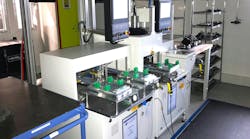By John Keller, Editor in Chief
The passing of former President Ronald Reagan and the solemn ceremonies marking the event are pivotal milestones in our nation's recent history — particularly for the U.S. military forces. There's a reason that American fighting men and women paying tribute to the former president obviously show a deep and abiding respect to the fallen leader.
President Reagan earnestly and sincerely loved the military; it's really that simple. Reagan's regard for the nation's fighting forces ran far more deeply, profoundly so, than photo poses beneath the 16-inch guns on the battleship USS New Jersey. In his eight years in office Reagan transformed the American military from the top down, most often for the better, and set trends in place that carry through to this day.
Granted, some of Reagan's military aims are distant memories — the failed goal of building a 600-ship Navy, reactivation of the nation's battleships, and a fighter and bomber force capable of going toe-to-toe in Europe with a rival world power.
Still, Reagan's influence on the U.S. military endures and is there for all to see — the M1 Abrams main battle tank and its upgraded variants, the B-2 stealth bomber that the Reagan administration kept secret for so long, the B-1 strategic bomber that Reagan resurrected from the scrap heap where his predecessor President Jimmy Carter tossed it, promotion of the Nimitz-class aircraft carrier that has one vessel appropriately named the USS Ronald Reagan, and what may be most significant: today's nascent ballistic missiledefense capability that Reagan famously began as the Strategic Defense Initiative, or "Star Wars."
Reagan's overhaul of the nation's military was of far greater substance than the procurement of much-needed new major weapon systems. Ordinary soldiers in the field felt the hand of Reagan; the transformation of the military even at the squad and platoon level was quick and meaningful. What made the change even more eventful was the contrast between the Reagan military and that which preceded it — a hollow force ground down by a decade of Vietnam and four years of neglect and social experimentation from the Carter administration.
Literally within months of Reagan's inauguration in January 1981, U.S. Army soldiers in Europe who had been wearing heavy and outdated steel helmets, and wore no more ballistic protection, were issued light and tough new Kevlar helmets and body armor. Many of these soldiers who had been used to standing idle at garrison duty started deploying to meaningful battlefield exercises as important parts of integrated forces.
In short, Reagan was deadly serious about strengthening and caring for the nation's soldiers, sailors, airmen, and Marines, and everyone who answered the unit roll call each morning knew it. Little wonder that groups of active-duty, reserve, and retired military personnel paid their last respects to Reagan at the Reagan Library in Simi Valley, Calif., and in the Capitol Rotunda in Washington.
I covered the military for nearly the entire Reagan presidency. I started my first newspaper job right out of college in June 1981, just five months after the former president took office. My job then, at a little paper in Central California, was covering the Navy's Light Attack Wing–Pacific at Lemoore Naval Air Station.
At that time the Navy had exactly one F/A-18 Hornet fighter-bomber deployed, right there at Lemoore, in the first training squadron set up for Hornet pilots. By the time I left that area nearly four years later the Navy under Reagan's leadership was well along with equipping all its light-attack squadrons with the F/A-18, and phasing out its outdated A-7 Corsair bombers and F-4 Phantom fighters.
In 1984 I had moved on to a newspaper in Clarksville, Tenn., where I watched Reagan's continued influence on the military. The Army's 101st Airborne Division (Air Assault) at nearby Fort Campbell, Ky., was in the midst of arming itself with new UH-60 Black Hawk utility helicopters, and was soon to receive the awesome new AH-64 Apache attack helicopter, all on Reagan's watch.
The next year I was in Washington covering the Pentagon for a national chain of newspapers, where I watched the Reagan military continue to deploy late-model M1 tanks in Europe to counter Soviet and Warsaw Pact forces there, speed up shipbuilding to bolster the nation's blue-water fleet, and unveil the F-17 fighter-bomber, the nation's first stealth aircraft.
Later, as a member of the Washington trade press, I saw the Reagan Administration's important influence on military technology research in organizations such as the Defense Advanced Research Projects Agency, the Air Force Research Laboratory, and the Office of Naval Research.
In these organizations during the Reagan presidency were planted the seeds that have led us to crucial weapon systems we take for granted today: smart munitions, unmanned aerial vehicles, cruise missiles, real-time sensor networks, and integrated military electronics architectures.
Reagan's revitalization of the military was not without its costs and drawbacks. Reagan poured money into the military at a rate unprecedented since World War II, and with that influx of money came corruption within the government and the defense industry. This was the era of $1,000 toilet seats, $200 claw hammers, and $100 diodes.
Perhaps inadvertently, the corruption that accompanied Reagan's rapid defense buildup has led us to procurement reforms such as the commercial off-the-shelf (COTS) initiative, which is 10 years old this year. COTS was institutionalized during the Clinton administration, but saw its beginnings under Reagan.
Reagan's passing, as do all milestones in our lives, prompts us to reflect and ask the question: did we do things the right way? Under Reagan, I'd argue that we did. Say what you want about how successive presidents have used the American military, Reagan laid the groundwork for what we have today — the United States undisputedly as the most militarily powerful nation on Earth.


